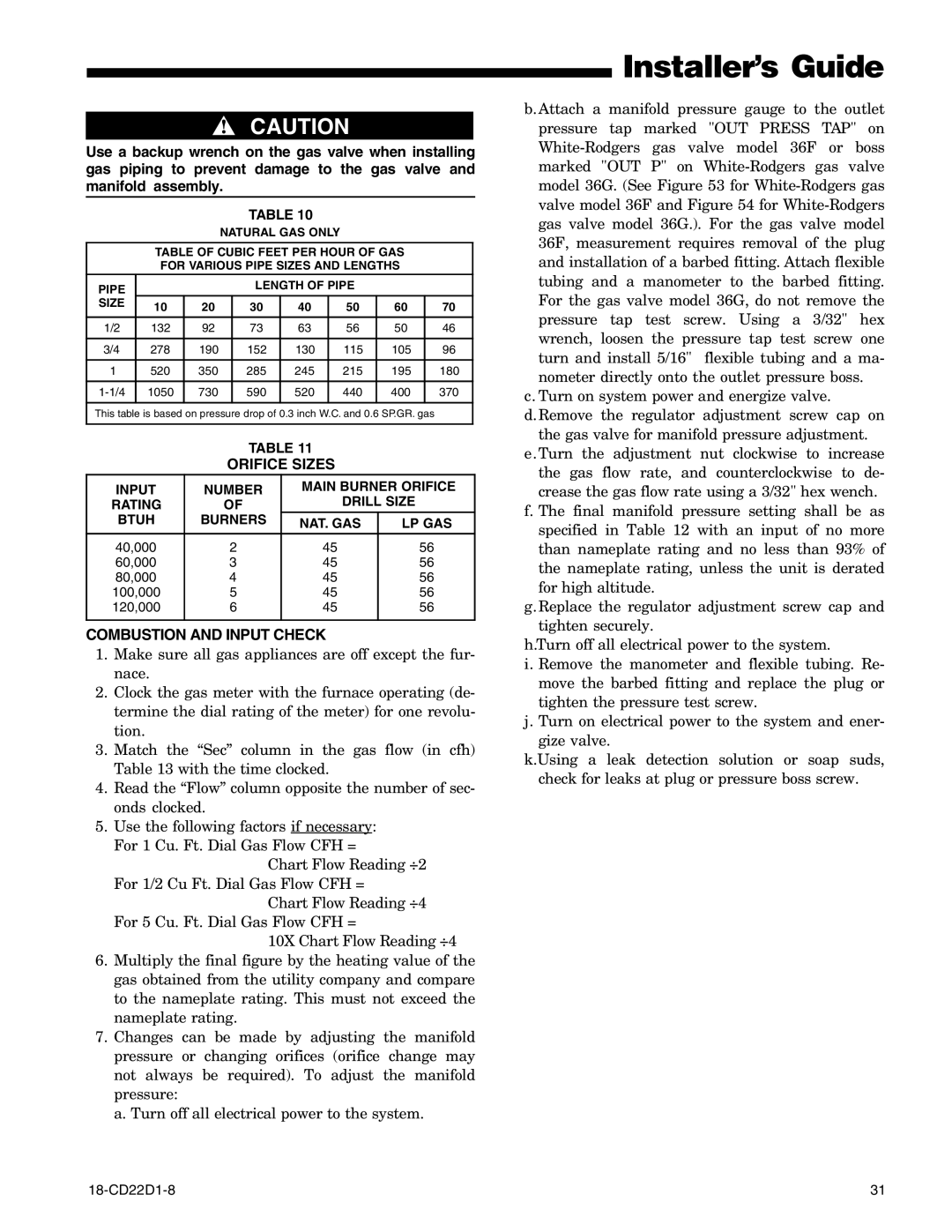
▲! CAUTION
Use a backup wrench on the gas valve when installing gas piping to prevent damage to the gas valve and manifold assembly.
TABLE 10
NATURAL GAS ONLY
TABLE OF CUBIC FEET PER HOUR OF GAS
FOR VARIOUS PIPE SIZES AND LENGTHS
PIPE |
|
| LENGTH OF PIPE |
|
| ||
|
|
|
|
|
|
| |
SIZE | 10 | 20 | 30 | 40 | 50 | 60 | 70 |
| |||||||
|
|
|
|
|
|
|
|
1/2 | 132 | 92 | 73 | 63 | 56 | 50 | 46 |
|
|
|
|
|
|
|
|
3/4 | 278 | 190 | 152 | 130 | 115 | 105 | 96 |
|
|
|
|
|
|
|
|
1 | 520 | 350 | 285 | 245 | 215 | 195 | 180 |
|
|
|
|
|
|
|
|
1050 | 730 | 590 | 520 | 440 | 400 | 370 | |
|
|
|
|
|
|
|
|
This table is based on pressure drop of 0.3 inch W.C. and 0.6 SP.GR. gas
TABLE 11
ORIFICE SIZES
INPUT | NUMBER | MAIN BURNER ORIFICE | |
RATING | OF | DRILL SIZE | |
BTUH | BURNERS | NAT. GAS | LP GAS |
|
|
|
|
40,000 | 2 | 45 | 56 |
60,000 | 3 | 45 | 56 |
80,000 | 4 | 45 | 56 |
100,000 | 5 | 45 | 56 |
120,000 | 6 | 45 | 56 |
|
|
|
|
COMBUSTION AND INPUT CHECK
1.Make sure all gas appliances are off except the fur- nace.
2.Clock the gas meter with the furnace operating (de- termine the dial rating of the meter) for one revolu- tion.
3.Match the “Sec” column in the gas flow (in cfh) Table 13 with the time clocked.
4.Read the “Flow” column opposite the number of sec- onds clocked.
5.Use the following factors if necessary: For 1 Cu. Ft. Dial Gas Flow CFH =
Chart Flow Reading ÷2
For 1/2 Cu Ft. Dial Gas Flow CFH =
Chart Flow Reading ÷4
For 5 Cu. Ft. Dial Gas Flow CFH =
10X Chart Flow Reading ÷4
6.Multiply the final figure by the heating value of the gas obtained from the utility company and compare to the nameplate rating. This must not exceed the nameplate rating.
7.Changes can be made by adjusting the manifold pressure or changing orifices (orifice change may not always be required). To adjust the manifold pressure:
a. Turn off all electrical power to the system.
Installer’s Guide
b.Attach a manifold pressure gauge to the outlet pressure tap marked "OUT PRESS TAP" on
c. Turn on system power and energize valve. d.Remove the regulator adjustment screw cap on
the gas valve for manifold pressure adjustment. e.Turn the adjustment nut clockwise to increase the gas flow rate, and counterclockwise to de- crease the gas flow rate using a 3/32" hex wench.
f. The final manifold pressure setting shall be as specified in Table 12 with an input of no more than nameplate rating and no less than 93% of the nameplate rating, unless the unit is derated for high altitude.
g.Replace the regulator adjustment screw cap and tighten securely.
h.Turn off all electrical power to the system.
i. Remove the manometer and flexible tubing. Re- move the barbed fitting and replace the plug or tighten the pressure test screw.
j. Turn on electrical power to the system and ener- gize valve.
k.Using a leak detection solution or soap suds, check for leaks at plug or pressure boss screw.
31 |
